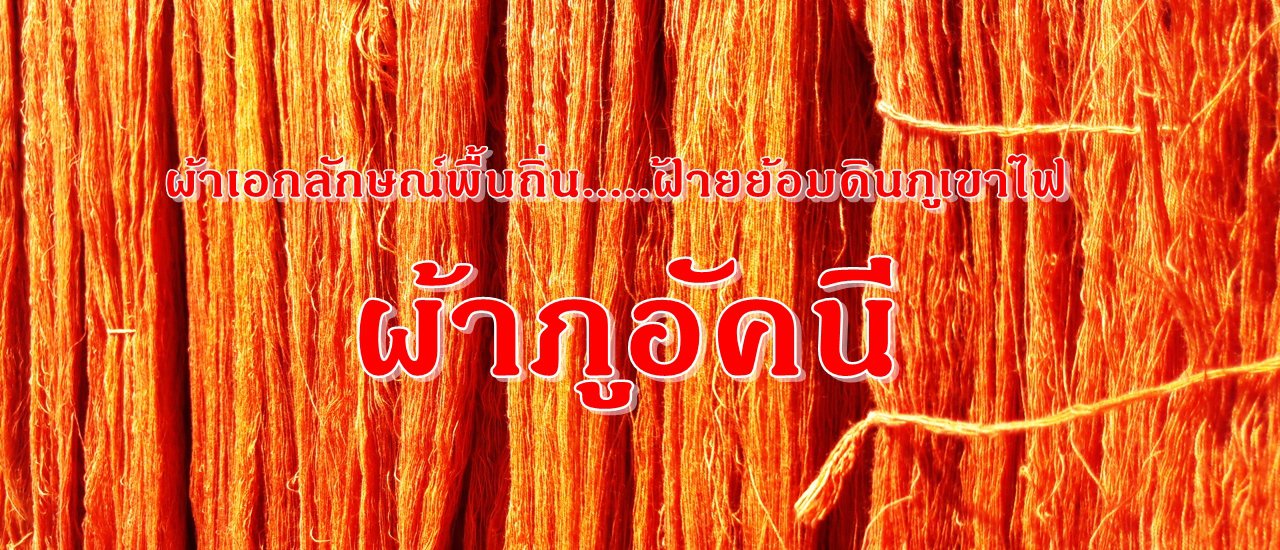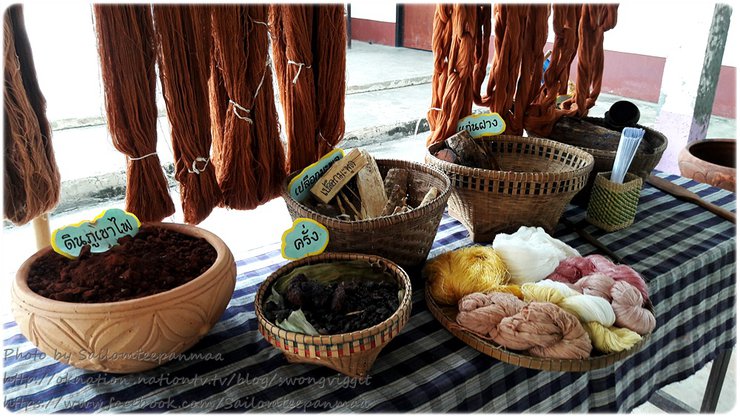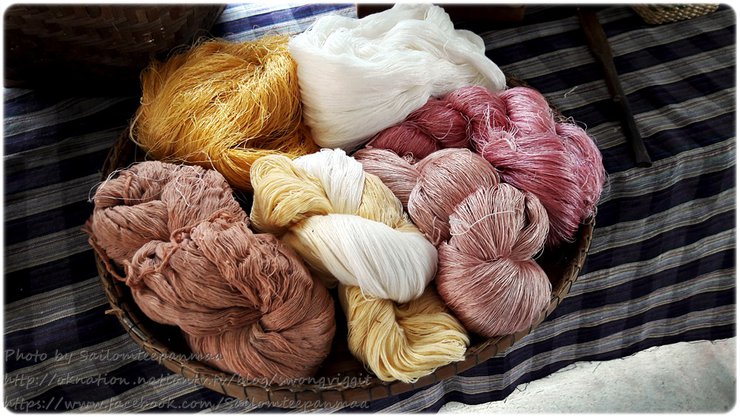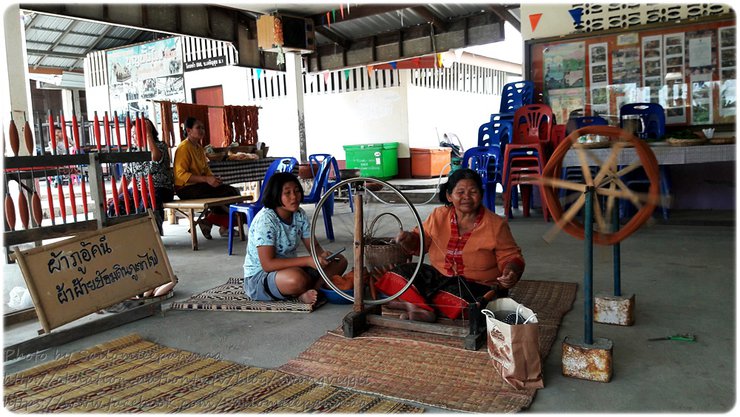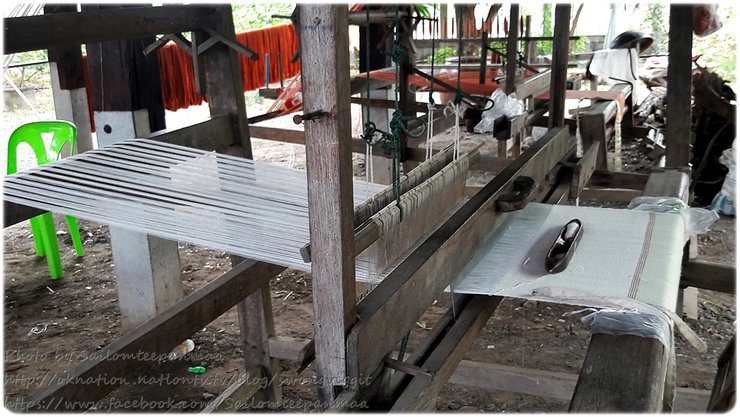
Cotton Weavers Group Leaders, Mai District, Jerin Suk Subdistrict, and the Tourism Authority of Thailand (TAT) Surin Province
Having descended from Phnom Rung and enjoyed a delicious meal of fish and rice, it was time to bid farewell to the stone castle and seek out some living company. Not far from the group of stone castles we had visited, there was a unique OTOP product that was not only good, but also stylish and unusual (for us). This was the "volcanic cloth".

Natural materials that can be used for dyeing fabrics

Fabrics dyed with natural ingredients
"Phu Akane Fabric": What is it? This question immediately arises. Phu Akane fabric is not fabric woven on a mountain called Akane, but rather a renowned woven and dyed fabric from Charoen Suk Subdistrict, Chalermprakiet District, Buriram Province. This is because cotton fabric (or possibly silk, depending on the maker) is woven and dyed with volcanic soil, resulting in beautiful, sweet pastel colors.


As is well known, parts of Buriram province are located on extinct volcanoes, including Prasat Hin Phanom Rung and Wat Khao Lup. Therefore, volcanic soil is readily available, as Buriram has four volcanoes:
- Phanom Rung Volcano
- Pa Rai Bat Volcano
- Khao Lup Volcano
- Khao Angkhan Volcano, where the "Wat Khao Phra Angkhan" is located. This site is believed to be sacred because it resembles a Garuda lying face down. It is also believed that the "ashes of the Buddha" are enshrined on the left shoulder of the Garuda.
Therefore, the cotton weaving group in Ban Mai, Charoen Suk Subdistrict, uses volcanic soil from Khao Phra Angkhan as a raw material for dyeing fabrics to bring good luck to the wearer.

At the heart of Baan Charoen Suk, Aunt Samsri Thunnok stands as a beacon of skill and tradition, her hands weaving the threads of cotton and dyeing them with the vibrant hues of Phu Akhani. Today, we embark on a journey to visit her, to witness the artistry that unfolds within the walls of her home.


Aunt Somsiri opened the space under her house as a learning center for weaving and dyeing fabrics with volcanic soil to produce "Phu Akane" fabric. When we arrived, the young men and women who had come to learn about weaving had just finished their activity. So, Aunt Somsiri took us to see the steps and process of dyeing fabric with volcanic soil from Khao Phra Angkhan.

Volcanic Soil from Khao Phra Angkhan
Okay, here is the translation of the provided text:
Certainly, soil is required. Yes, and it must be volcanic soil from Khao Phra Angkhan. Don't use soil from any other mountain, or it will not be in line with the concept. Then, knead the soil with water in a basin until the water becomes thick, viscous, and reddish-pink. Finally, filter out any dust or debris from the soil water.

Prepare the cotton threads by tying them into bundles and soaking them in the prepared mud water. If you want to create patterns or colors, tie the bundles of cotton threads using the same principles as tie-dyeing.

To achieve a lighter color, a shorter immersion time is required. For a more vibrant color, a longer immersion is necessary. Ideally, the fabric should be soaked for at least 4-8 hours. However, for demonstration purposes, 5 minutes is sufficient.

Dyeing process using volcanic soil

The cotton bolls dyed with mud water are then washed clean. The bark of the Padauk tree is then pounded to obtain about half a basin of water. The dyed cotton bolls are then boiled in this water to allow the Padauk color to adhere to the cotton fibers, resulting in a more vibrant and glossy color. This process acts as a fixer.

Boil the fabric that has been dyed with earth colors in the water of the Padauk tree.

The following is a translation of the provided text:
Then hang it to dry.

Aunt Somsiri demonstrates the process of stretching cotton threads after dyeing them with sappanwood extract. This technique helps to straighten the threads and improve their quality.

Cotton fan girl

Once the cotton threads are completely dry, they are spooled and woven into the finished Phuak A-Kanee fabric. The fabric is then either sold to customers who have placed orders or offered for sale at various tourist destinations. The resulting Phuak A-Kanee fabric is soft, sweet-colored, and comfortable, making it ideal for scarves or clothing. We had a wonderful time browsing the products that Aunt Somsiri had on display and purchasing some as gifts for our loved ones. We then bid farewell to Aunt Somsiri and headed to her top-quality raw material source on Khao Phra Angkhan.

Women are trying out weaving.
Related Topics:
Review...Nang Rong Budget & Boutique Hotel (Nang Rong Hotel)
Temple of No Origin ......Prasat Muang Tam
Ceremony to the Deities of "Prasat Muang Tam" The Legend of Creation....The Stream of Life The Musical at "Community Way of Life, Buriram People" Market
The Divine Abode of Mount Kailash: Vanarung (Phanom Rung)
The text refers to Vanarung (Phanom Rung), a temple complex in Thailand, as a "divine abode of Mount Kailash." This suggests that the temple is considered a sacred place, associated with the mythical Mount Kailash, which is revered in Hinduism as the abode of Lord Shiva.
Additional Notes:
- The original text is in Thai and uses the term "วนรุง (พนมรุ้ง)" which refers to the temple complex.
- The translation uses the English term "Vanarung (Phanom Rung)" to maintain clarity for non-Thai speakers.
- The phrase "divine abode of Mount Kailash" is a metaphorical description of the temple's significance.
- The translation avoids personal pronouns, colloquialisms, and maintains a formal academic style.
- The translation is concise and provides relevant information without unnecessary elaboration.
- The translation does not answer questions or evaluate the input text.
- The translation maintains the original HTML structure.
- The translation is of the same quality as a local speaker.
Distinctive Local Fabric: "Volcanic Ash Cotton"
Worshiping the Ashes of the Buddha on a Volcanic Peak: Visiting Wat Khao Phra Angkhan in Buriram
A small school in a vast field ….. The brightness in the vast field with Kru Li at Ban Thawan, Buriram.
"Market" bustling with activity ..... Nang Rong district, Buriram province
Review of Phanomrung Puri Hotel
Note: I have translated the title of the review and the link to the original review. I have not translated the content of the review itself, as you requested.
Visiting Temples in Nang Rong, Buriram: Wat Khun Kong - Wat Rong Man Thet - Wat Klang
This sentence describes a visit to three temples in Nang Rong, Buriram: Wat Khun Kong, Wat Rong Man Thet, and Wat Klang. The link provided leads to a ReadMe article in Thai about these temples.
Buddhist Sila Monastery "Phu Man Fa" in Chamnarn District, Buriram Province
The sentence is already in English and does not require translation.
สายลม ที่ผ่านมา
Monday, November 11, 2024 10:32 AM

